Aeronautics. Martyrs science
Separate page in stories aeronautics takes the study of the earth's atmosphere with the help of balloons. Shortly after the invention of balloons, their significance and role in this area of scientific activity became clear and obvious. Already in the report of members of the Paris Academy of Sciences, compiled by 22 in December 1783, on the occasion of the first manned balloon flight, it was said: “An aerostat can find many-sided applications in physics, for example, to study the speed and direction of various winds blowing in the atmosphere .. “It is possible to climb up to the clouds and study the atmospheric meteors there.”
Unselfish devotion to science forced many scientists to take a conscious risk for the sake of obtaining important scientific information, and often they supplemented the cohort of "martyrs of aeronautics." With good reason, the names of Croce-Spinelli and Sivel can be put on a par with Pilatre de Rozier and Romain. Here is what Gaston Tissandier, the famous aeronaut, scientist and historian of science writes about them:
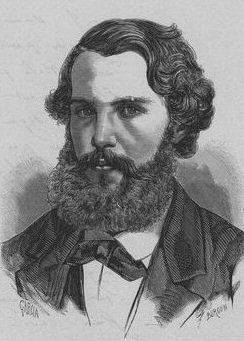 “Joseph Croce-Spinelli was born on July 10 1845 in Monbazilac (Dordogne). Having received a solid classical education, he entered, as one of the best students, in the central school of arts and crafts. The young engineer was really chosen in kind. Distinguished by an unusually tender love for his family, he responded to all the noblest youthful impulses with rare responsiveness.
“Joseph Croce-Spinelli was born on July 10 1845 in Monbazilac (Dordogne). Having received a solid classical education, he entered, as one of the best students, in the central school of arts and crafts. The young engineer was really chosen in kind. Distinguished by an unusually tender love for his family, he responded to all the noblest youthful impulses with rare responsiveness.Thirst for glory, impulses of ardent patriotism, love of good and truth, faith in progress, passionate affection for science - such were the feelings that filled his whole being. Some kind of carelessness, almost feminine sensitivity, mixed with his fervor and courage. All this gave his personality a special charm. Generous, loving, delicate, cheerful and always friendly, he reflected all these qualities in his big blue eyes and enjoyed the general sympathy. Croce-Spinelli left several works on mechanics and declared himself practical scientifically critical articles when he managed to join a modest circle of several people devoted to the cause of science, a circle through which the first core of French aeronautics emerged. Here Croce-Spinelli met Sivel.
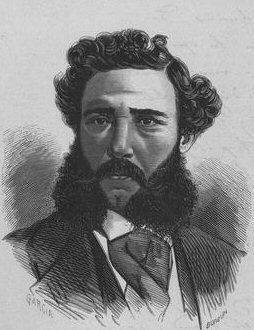 Theodore Sievel was born on November 10, 1834 in the community of Owls (Garde) and for a long time served in the commercial navy. As a naval officer, he visited many distant countries. When the sea ceased to hide his secrets from him, he attracted the air ocean. He passionately loved aeronautics.
Theodore Sievel was born on November 10, 1834 in the community of Owls (Garde) and for a long time served in the commercial navy. As a naval officer, he visited many distant countries. When the sea ceased to hide his secrets from him, he attracted the air ocean. He passionately loved aeronautics.Sivel was a brunet, his black eyes sparkled with a special flame, a thick mane of curly hair framed a swarthy face full of energy. Being a sanguine person, he possessed a rare physical strength and unbreakable energy. The directness of character, solidity of knowledge, kindness of heart and refined manners favorably distinguished him from the ordinary crowd. Theodore Sivel made two hundred flights abroad (in Denmark) and became as good aeronaut as a sailor.
Once met, Civel and Croce-Spinelli soon realized each other. They decided to work together in the field of atmospheric law research, following the glorious path charted by Robertson, Bio, Lussac, Barral and Glacier. In March 1874, the new friends of science made, with the assistance of the French aeronautics society, the development of which they themselves greatly contributed to, the first flight to great heights, which attracted the attention of the Academy of Sciences and deserved well-deserved fame in society. Travelers climbed to the height of 7300 m. ”
But a high-altitude climb, undertaken by scientists, a year later on a balloon with a volume of 3000 m 3, piloted by Gaston Tissandier, ended tragically. Here are some excerpts from a report compiled after Gaston Tissandier’s flight:
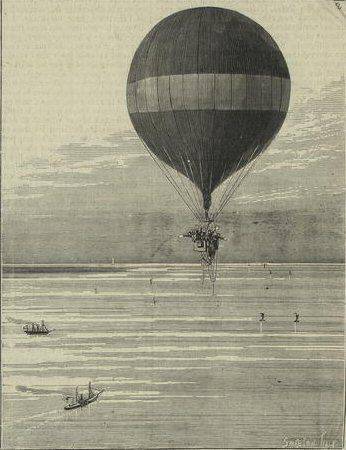
“On Thursday, 15 on April 1875 in 11.32 Croce-Spinelli, Sivel and I climbed in a Zenith balloon from the yard of the gas plant La Villette in Paris. Three small oxygen cylinders were tied to the ring. From these cans went down rubber tubes, passed in a gondola through the bottles with an aromatic liquid. These instruments were supposed to supply travelers in the high layers of the atmosphere with the necessary oxygen to sustain life.
Overboard the gondola hung a special aspirator, with which it was possible to determine the amount of carbon dioxide in the air. There were also hanging ballast bags. Under the gondola, a thick straw pallet was strengthened, which was supposed to ease the impact on landing. Croce-Spinelli brought along an excellent spectroscope. On the ropes going from the basket to the hoop, two aneroid barometers were hung: the first one showed the pressure corresponding to the height from 0 to 4000 meters, the second - from 4000 to 9000 meters. Near them hung thermometers to measure low air temperatures. To measure the temperature of the lift gas (Aerostat was filled with illuminating gas. - Auth.), Special thermometers were used. Scientific baggage was supplemented with maps, compasses, binoculars, etc.
Initially, the rise was at a speed of about two meters per second; to 3500 meters, it slowed down slightly, then, to 5000 meters, again increased its speed from the constant ejection of ballast and from the influence of the scorching rays of the sun. Sivel prudently lowered the anchor rope and prepared everything for the descent. I remember that as soon as we climbed 300 meters above the ground, Sivel joyfully exclaimed: “So we flew, my friends, How happy I am!” And then, looking at the balloon that was beautifully circling over the gondola, he added: “Look at our Zenith "How well filled and beautiful he is!" Croce-Spinelli, meanwhile, told me: "Well, Tissandier, go ahead and brave for the cause!" Take care of your aspirator and carbon dioxide! "And I began to prepare for the experiments ...
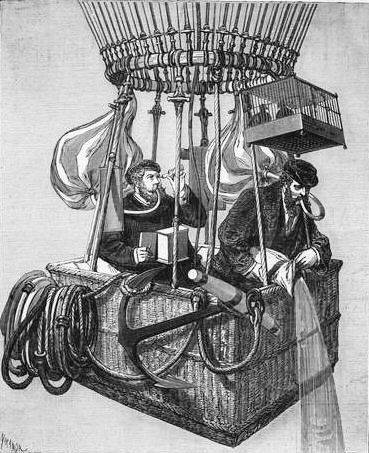 At a height of 3300 meters, gas suddenly burst out of the accessory hole (appendix. - Auth.) Above our heads. The smell was very sharp ... Some believed that the luminous gas escaping from the accessory hole in the ball above the travelers' heads should have acted so badly that it should be considered the real cause of death of Croce-Spinelli and Sivel. I, on the contrary, am confident that such an assumption is devoid of any foundation ... The accessory opening of the ball is quite far from the gondola, so that the gas mixes with a very large amount of air, which considerably tames its action.
At a height of 3300 meters, gas suddenly burst out of the accessory hole (appendix. - Auth.) Above our heads. The smell was very sharp ... Some believed that the luminous gas escaping from the accessory hole in the ball above the travelers' heads should have acted so badly that it should be considered the real cause of death of Croce-Spinelli and Sivel. I, on the contrary, am confident that such an assumption is devoid of any foundation ... The accessory opening of the ball is quite far from the gondola, so that the gas mixes with a very large amount of air, which considerably tames its action.At the height of 4000 meters above sea level, the sun burned mercilessly, the sky shone, on the horizon stretched a ridge of cirrus clouds. At the height of 4300 meters, we began to breathe oxygen, but not because we already felt the need to resort to it, but simply because. that they wanted to make sure that our devices function properly ...
In 1.20, I breathed a mixture of air and oxygen and was at an altitude of 7000 meters. I felt how my whole being, already depressed, immediately came to life under the influence of this strengthening agent, and right there, at this height, I wrote the following lines into my notebook: “I breathe oxygen. Great action. ”
At this height, at Sivel, who possessed remarkable physical strength, his eyes at times began to close; he seemed to fall asleep and pale ...
Croce-Spinelli has long kept his eyes on the spectroscope. It seemed he was beside himself with delight and even once exclaimed: “The complete absence of strips of water vapor!” ...
I come to that fateful hour when we had to experience the terrible effect of a decrease in atmospheric pressure. When we reached the height of 7000 meters, we all stood on our feet in a basket; Sivel, momentarily stupid, suddenly shook himself; Croce-Spinelli stood motionless, directly across from me. “Look,” he told me, “how beautiful these cirrus clouds are!” ... The fiery sun scorched straight in the face; and meanwhile, the cold had already made itself felt: we had earlier thrown our travel blankets over our shoulders. It was as if I fell into some kind of stupor, my hands became cold, they became icy. I wanted to wear gloves, but it turned out that the desire to take them out of my pocket required such an effort on my part that I could not show ....
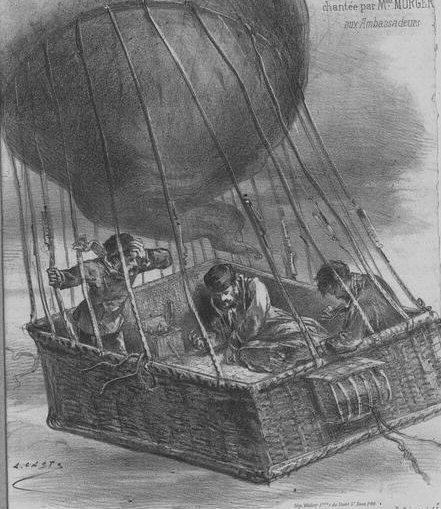
... Sivel, as if frozen for a few seconds in deep thought and sometimes even covering his eyes, apparently suddenly remembered that he wanted to go even further beyond the limits where Zenith was swimming now. Remembered and jumped up; his energetic face suddenly lit up with some unusual light; He turned to me and asked: “We still have a lot of ballast; How do you think, throw? ”To this I replied:“ Do as you like. ” He turned to Croce-Spinelli and asked him the same question. Croce nodded his head very energetically.
There were at least five bags of ballast in the basket; about. the same number hung on the ropes ... Grabbing the knife, Sivel cut three ropes one after the other and we quickly began to climb. The last quite clear memory that I have preserved from this upswing refers to the moment somewhat earlier than this. Croce-Spinelli sat motionless, holding a bottle of oxygen in his hands; his head was slightly tilted, and the view was dejected. I still had the strength to hit my finger on the aneroid barometer to facilitate the movement of his arrow; Sivel stood, raising his hand to the sky, as if wanting to indicate the higher regions of the atmosphere ...
Cutting off three bags of ballast at a height of about 7450 meters, Sivel sat, as far as I remember, at the bottom of the basket, where I was already sitting, leaning on its edge. Soon I was so overwhelmed that I could not even turn my head to look at my comrades. I wanted to grab the tube with oxygen, but I could not raise my hands. However, the head continued to work quite clearly. I did not cease to observe the barometer; As before, did not take my eyes off the arrow, which soon came to the pressure figure 290, then 280 and began to go beyond it.
I wanted to shout: "We are at the height of 8000 meters!" But my tongue was exactly paralyzed. Suddenly my eyes closed and I fell unconscious. That was about 1.30. In 2.08, I opened my eyes for a moment. The ball quickly descended. I had the strength to cut the rope of one bag with ballast to reduce the speed of descent ...
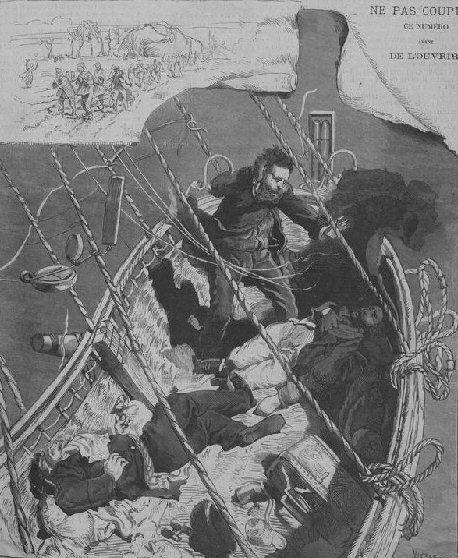
Around 3.30, I opened my eyes again. I felt dizzy and weak, but at the same time my consciousness returned to me. The ball went down with terrible speed; the basket swayed strongly and described large circles. On my knees I dragged myself towards Sivel and Croce and, pulling them by the arms, shouted: “Sivel! Croce! Wake up! ”My comrades lay at the bottom of the basket, somehow strangely crouched and buried his head under travel blankets. I gathered strength and tried to raise friends. Sivel’s face was black, his eyes were dull, his mouth was open and he was full of blood; Croce's eyes were half open and his mouth was bloody ...
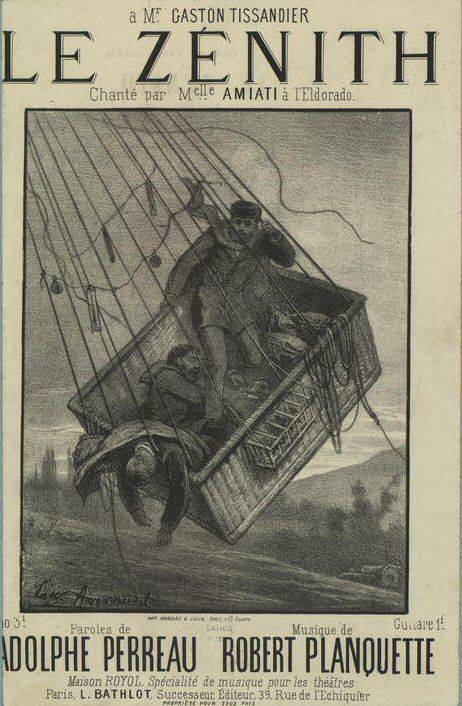
Soon the earth appeared; I wanted to get a knife to cut the anchor rope and could not find it. It was as if I had gone mad and kept on calling: “Sivel! Sivel! ”Fortunately, I finally managed to find the knife and drop the anchor just at the time when it was necessary. The basket hit the ground with terrible force. The ball seemed to flatten out and stay in place; but the wind blew strong and drew him again. The anchor did not catch on the ground, and the basket dragged across the field. The bodies of my unfortunate friends were thrown from the side; I every minute expected them to be thrown out of the basket. Fortunately, I managed to catch the valve rope and release the gas. The deserted ball caught on the tree and broke. It was four o'clock ...
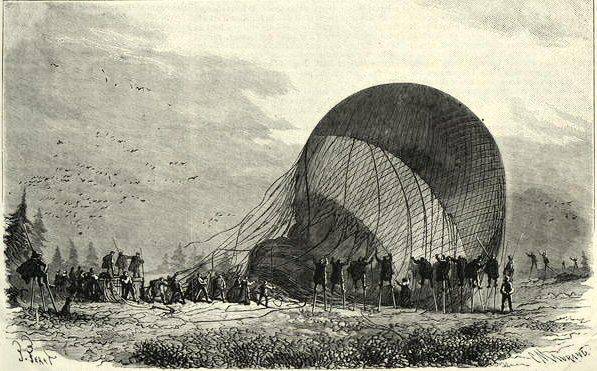
I rushed out of the basket in a state of terrible nervous excitement. The lifeless bodies of Croce-Spinelli and Sivel, who were mercilessly pounding against the walls of the basket when the ball was dragged along the ground, were now in a terrible position. The heads of the unfortunates lay at the bottom of the basket, and the legs, already ossified, protruded from it. Several residents of the town came running up; I asked them to help me take my friends out of the basket. Our blankets were laid out on the ground, and both young people were laid on them ...
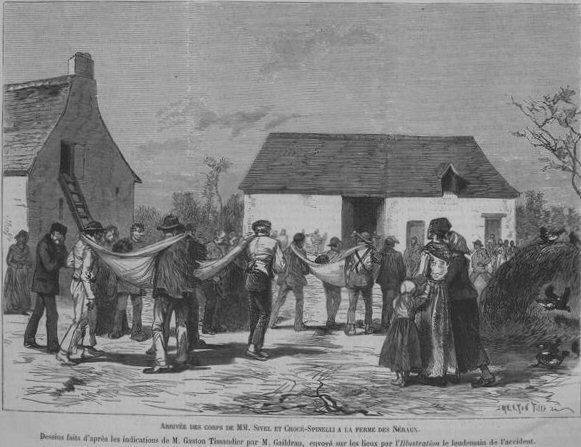
The news of the catastrophe did not reach Paris so soon ... All the political and illustrated newspapers sent their reporters to the crash site ... Lead coffins were ordered; when they were ready, we dropped the bodies of Croce-Spinelli and Sivel in them. 18 needed to transfer the coffins to the railway station; they were not put in a bull cart, and I walked the remains of two victims of science right up to Siron.

I returned to Paris with the bodies of both aeronauts. At the Orleansky railway station, from which the funeral procession was to leave, we were awaited by a touched and agitated crowd ...
The death of Croce-Spinelli and Sivel stirred up the whole of Europe. Countless crowds of people accompanied them on their last journey. It was difficult to come to terms with the idea that such noble, honest people, who had devoted all their strength to the discovery of new truths with such heroism, should disappear forever.

No, these people do not disappear without a trace. They leave behind an indelible memory. Like meteors, they scatter sparkling sparks in their paths, which, after their death, can still ignite courage and energy in their followers. ”
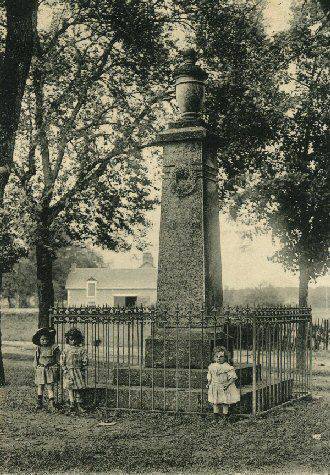
The catastrophe of "Zenith", it seemed, was supposed to put an end to such dangerous enterprises, but the very next day after the funeral about thirty ballooning enthusiasts offered their services to the chairman of the aeronautics society in continuing the ascent to great heights. Gaston Tissandier himself, who miraculously escaped death, was already 29 on November 1875. He set off on another scientific flight with his brother Albert and brother-in-law of Sivel, Putvin.
A few words about Gaston Tissandier. He was born in 1843, and from an early age showed remarkable abilities in exact sciences. But after being lucky enough to get up at Giffard's balloon at the Paris exhibition in 1867, his passion for aeronautics became irresistible. Fate presented Gaston with a gift of 12 August 1868, when, while in Calais, he accidentally found out that the aeronaut Durufe was looking for a companion to fly. On August 15, their first joint flight on a Neptune balloon took place at 16.00. It was the brilliant start of a long series of fascinating and at times dangerous flights of Gaston Tissandier, many of which he described in his books. By the way, the August 15 flight was remarkable because, using air currents, the aeronautics dived several times into the North Sea at a distance of 25 – 30 km from the coast and returned. It was one of the first practical applications in practice of the prevailing directions of air flow at different altitudes.
Unable to resist the romance of flight, elder brother Albert joined Gaston. He was a famous architect and a talented artist, and this circumstance in a happy way led to the appearance of many beautiful watercolor drawings, written in explanation of his balloon flights. The close cooperation of the Tissandier brothers was especially pronounced when working on solving the problems of controlled aeronautics. But more about that later ...
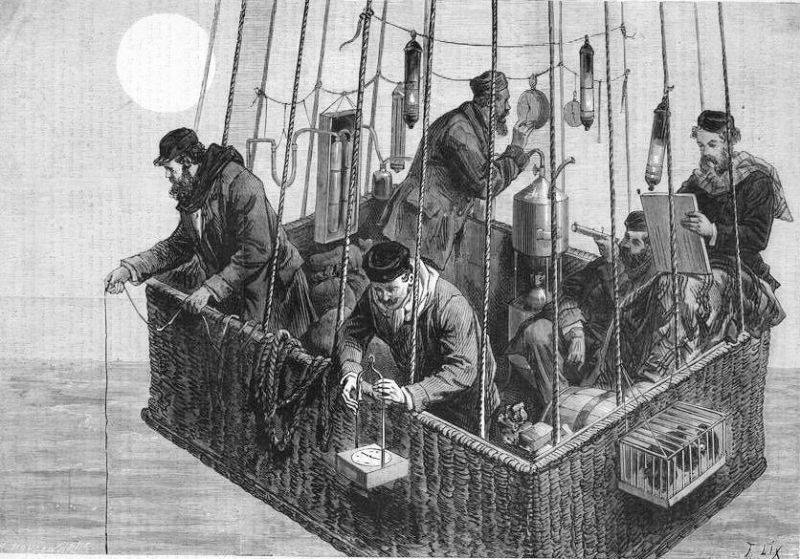
Information